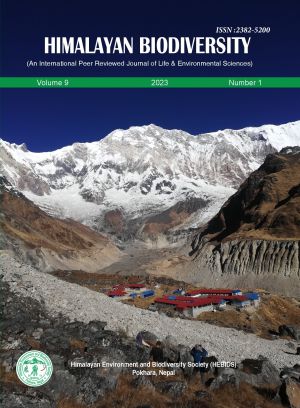Visitors’ Environmental Impact on Conservation Areas: An Evaluation of Annapurna Base Camp Trekking Trail in the Annapurna Conservation Area, Nepal
DOI:
https://doi.org/10.3126/hebids.v9i1.59583Keywords:
Biodiversity, conservation areas, ecosystem, sustainable tourism, tourism environmental impactAbstract
Worldwide, natural landscapes possessing exceptional biodiversity are declared as protected areas for conserving unique biodiversity and ecosystems. With the invention of the concept of ecotourism, protected areas have been established as the most preferred nature-based tourism destinations. The increased tourism activity within the conservation area generates many negative environmental impacts which eventually deteriorate the ecosystem and threaten the biodiversity. The Annapurna Conservation Area is a mountain ecosystem providing shelter for various unique biodiversity and is also famous for tourism activity. Annapurna Base Camp Trekking trail within the Annapurna conservation area has been established as one of the most preferred trekking destinations, however, the negative environmental impacts of tourism on this trekking trail are yet unknown. In this study, we evaluated the environmental impacts of tourism across the Annapurna Base Camp Trekking trail via field visit observation, group discussion, and questionnaire survey on a Likert scale ranging from one to five. The result revealed that solid waste generation and the spread of invasive alien plants across the trekking trail are the obvious environmental impacts of tourism while impacts on other aspects of the environment are almost insignificant and within the threshold limit. The findings thus indicate the need to devise an effective strategy for mitigating solid waste generation and preventing the spread of invasive plants. This finding provides important insights to formulate policies for the management of tourism in conservation areas and protect the biodiversity, landscape, and ecosystem of the Annapurna Base Camp Trekking trail and other similar trekking destinations across the entire country.
Downloads
Downloads
Published
How to Cite
Issue
Section
License
© Himalayan Environment and Biodiversity Society (HEBIDS)

